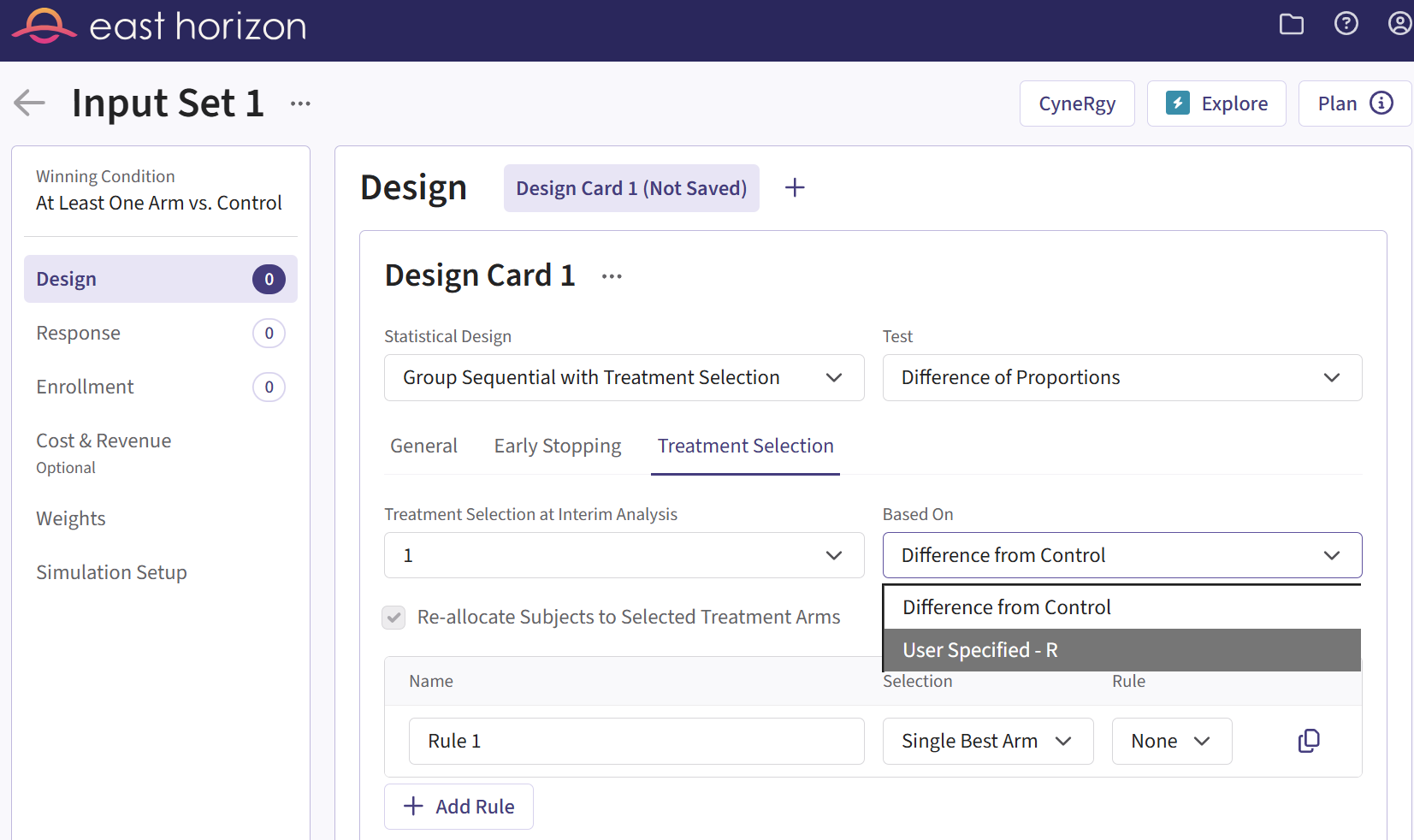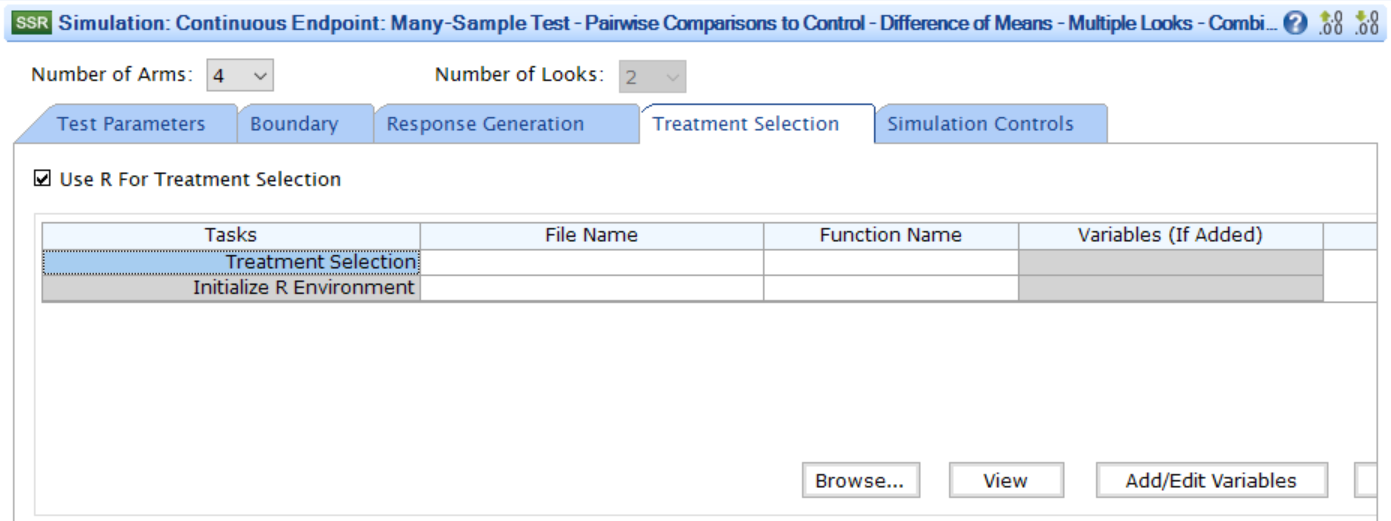
Integration Point: Treatment Selection
Gabriel Potvin
October 31, 2025
IntegrationPointTreatmentSelection.RmdGo back to the Getting Started: Overview page
Description
The Treatment Selection integration point allows you to customize the selection of arms to carry forward after an interim analysis using a custom R script. Instead of relying on the limited settings (rules) of East or East Horizon, such as selecting a fixed number of top treatments or applying a threshold, you can implement entirely alternative methods to better suit your trial’s requirements. For example, you could use Bayesian rules.
Availability
East Horizon Explore
This integration point is available in East Horizon Explore for the following study objectives and endpoint types:
| Time to Event | Binary | Continuous | Continuous with repeated measures | Count | Composite | Dual TTE-TTE | Dual TTE-Binary | |
|---|---|---|---|---|---|---|---|---|
| Two Arm Confirmatory | ❌ | ❌ | ❌ | ❌ | ❌ | ❌ | ❌ | ❌ |
| Multiple Arm Confirmatory | 🔜 | ✅ | ✅ | - | - | - | - | - |
| Dose Finding | - | - | 🔜 | - | - | - | - | - |
Legend
| Icon | Meaning |
|---|---|
| ✅ | Available |
| ❌ | Not available |
| 🔜 | Coming soon |
East Horizon Design
This integration point is available in East Horizon Design for the following tests (click to expand/collapse):
| Test | Study Objective | Endpoint | Availability |
|---|---|---|---|
| Single Mean (One Arm Design) | One Arm Exploratory/Confirmatory | Continuous | ❌ |
| Mean of Paired Differences (Paired Design) | One Arm Exploratory/Confirmatory | Continuous | ❌ |
| Mean of paired Ratios (Paired Design) | One Arm Exploratory/Confirmatory | Continuous | ❌ |
| Single Proportion (One Arm Design) | One Arm Exploratory/Confirmatory | Binary | ❌ |
| Simon’s Two Stage (One Arm Design) | One Arm Exploratory/Confirmatory | Binary | ❌ |
| Logrank Weibull Distribution (One Arm Design) | One Arm Exploratory/Confirmatory | Time to Event | ❌ |
| Parametric Weibull Distribution (One Arm Design) | One Arm Exploratory/Confirmatory | Time to Event | ❌ |
| Logrank Exponential Distribution (One Arm Design) | One Arm Exploratory/Confirmatory | Time to Event | ❌ |
| Single Poisson Rate (One Arm Design) | One Arm Exploratory/Confirmatory | Count | ❌ |
| Difference of Means (Parallel Design) | Two Arm Confirmatory | Continuous | ❌ |
| Ratio of Means (Parallel Design) | Two Arm Confirmatory | Continuous | ❌ |
| Difference of Means (Crossover Design) | Two Arm Confirmatory | Continuous | ❌ |
| Ratio of Means (Crossover Design) | Two Arm Confirmatory | Continuous | ❌ |
| Difference of Proportions (Parallel Design) | Two Arm Confirmatory | Binary | ❌ |
| Ratio of Proportions (Parallel Design) | Two Arm Confirmatory | Binary | ❌ |
| Odds Ratio of Proportions (Parallel Design) | Two Arm Confirmatory | Binary | ❌ |
| Fisher’s Exact (Parallel Design) | Two Arm Confirmatory | Binary | ❌ |
| Logrank Test Given Accrual Duration and Accrual Rates (Parallel Design) | Two Arm Confirmatory | Time to Event | ❌ |
| Logrank Test Given Accrual Duration and Study Duration (Parallel Design) | Two Arm Confirmatory | Time to Event | ❌ |
| Logrank Test Given Accrual Duration and Accrual Rates (Population Enrichment) | Two Arm Confirmatory | Time to Event | ❌ |
| Ratio of Poisson Rates (Parallel Design) | Two Arm Confirmatory | Count | ❌ |
| Ratio of Negative Binomial Rates (Parallel Design) | Two Arm Confirmatory | Count | ❌ |
| Win Ratio (Parallel Design) | Two Arm Confirmatory | Composite | ❌ |
| MAMS Difference of Means (Pairwise Comparisons to Control) | Multiple Arm Confirmatory | Continuous | ❌ |
| MAMS Difference of Means: Combining P-Values (Pairwise Comparisons to Control) | Multiple Arm Confirmatory | Continuous | 🔜 |
| MAMS Difference of Proportions (Pairwise Comparisons to Control) | Multiple Arm Confirmatory | Binary | ❌ |
| MAMS Difference of Proportions: Combining P-Values (Pairwise Comparisons to Control) | Multiple Arm Confirmatory | Binary | 🔜 |
| MAMS Logrank (Pairwise Comparisons to Control) | Multiple Arm Confirmatory | Time to Event | ❌ |
| MAMS Logrank: Combining P-Values (Pairwise Comparisons to Control) | Multiple Arm Confirmatory | Time to Event | 🔜 |
East
This integration point is available in East for the following tests (click to expand/collapse):
| Test | Number of Samples | Endpoint | Availability |
|---|---|---|---|
| Difference of Means (Parallel Design) | Two Samples | Continuous | ❌ |
| Difference of Proportions (Parallel Design) | Two Samples | Discrete | ❌ |
| Ratio of Proportions (Parallel Design) | Two Samples | Discrete | ❌ |
| Odds Ratio of Proportions (Parallel Design) | Two Samples | Discrete | ❌ |
| Logrank Test Given Accrual Duration and Accrual Rates (Parallel Design) | Two Samples | Survival | ❌ |
| Logrank Test Given Accrual Duration and Study Duration (Parallel Design) | Two Samples | Survival | ❌ |
| Chi-Square for Specified Proportions in C Categories (Single Arm Design) | Many Samples | Discrete | ❌ |
| Two Group Chi-Square for Proportions in C Categories (Parallel Design) | Many Samples | Discrete | ❌ |
| Multiple Looks - Combining P-Values (Pairwise Comparisons to Control - Difference of Means) | Many Samples | Continuous | ✅ |
| Multiple Looks - Combining P-Values (Multiple Pairwise Comparisons to Control - Difference of Proportions) | Many Samples | Discrete | ✅ |
| Multiple Looks - Combining P-Values (Pairwise Comparisons to Control - Logrank Test) | Many Samples | Survival | ✅ |
Instructions
In East Horizon Explore
You can set up a treatment selection function under Based On in the Treatment Selection tab of a Design Card while creating or editing an Input Set. The statistical design must be Group Sequential with Treatment Selection.
Follow these steps (click to expand/collapse):
- In the Design Card, select Group Sequential with Treatment Selection under Statistical Design.
- Navigate to the Treatment Selection tab.
- Select User Specified-R from the dropdown in the Based On field.
- Browse and select the appropriate R file (
filename.r) from your computer, or use the built-in R Code Assistant to create one. This file should contain function(s) written to perform various tasks to be used throughout your Project. - Choose the appropriate function name. If the expected function is not displaying, then check your R code for errors.
- Set any required user parameters (variables) as needed for your function using + Add Variables.
- Continue creating your project.
For a visual guide of where to find the option, refer to the screenshot below:

In East
You can set up a treatment selection function in East by navigating to the Use R For Treatment Selection setting of the Treatment Selection tab of a Simulation Input window.
Follow these steps (click to expand/collapse):
- Choose the appropriate test in the Design tab.
- In the Simulation Input window, navigate to the tab Treatment Selection and select Use R For Treatment Selection.
- A list of tasks will appear. Place your cursor in the File Name field for the task Treatment Selection.
- Click on the button Browse… to select the
appropriate R file (
filename.r) from your computer. This file should contain function(s) written to perform various tasks to be used throughout your Project. - Specify the function name you want to initialize. To copy the function’s name from the R script, click on the button View.
- Set any required user parameters (variables) as needed for your function using the button Add/Edit Variables.
- Continue setting up your project.
For a visual guide of where to find the option, refer to the screenshot below:

Input Variables
When creating a custom R script, you can optionally use specific
variables provided by East Horizon’s engine itself. These variables are
automatically available and do not need to be set by the user, except
for the UserParam variable. Refer to the table below for
the variables that are available for this integration point, outcome,
and study objective.
| Variable | Type | Description |
|---|---|---|
| SimData | Data Frame | Subject data generated in current simulation, one row per subject.
To access these variables in your R code, use the syntax:
SimData$NameOfTheVariable, replacing
NameOfTheVariable with the appropriate variable name. Refer
to the table below for more information. |
| DesignParam | List | Input parameters which may be needed to compute test statistic and
perform test. To access these variables in your R code, use the syntax:
DesignParam$NameOfTheVariable, replacing
NameOfTheVariable with the appropriate variable name. Refer
to the table below for more information. |
| LookInfo | List | Input parameters related to multiple looks which may be needed to
compute test statistic and perform test. To access these variables in
your R code, use the syntax: LookInfo$NameOfTheVariable,
replacing NameOfTheVariable with the appropriate variable
name. Refer to the table below for more information. |
| UserParam | List | Contains all user-defined parameters specified in the East Horizon
interface (refer to the Instructions
section). To access these parameters in your R code, use the syntax:
UserParam$NameOfTheVariable, replacing
NameOfTheVariable with the appropriate parameter name. |
Expected Output Variable
East Horizon expects an output of a specific type. Refer to the table below for the expected output for this integration point:
| Type | Description |
|---|---|
| List | A named list containing TreatmentID,
AllocRatio, and ErrorCode. |
Expected Members of the Output List
| Members | Type | Description |
|---|---|---|
| TreatmentID | Vector of Integer | Vector of length equal to the number of selected treatment arms, containing the indices of the treatments, starting from 1 and excluding the control. For example, [1, 2] indicates that treatment arms 1 and 2 are carried forward. |
| AllocRatio | Vector of Numeric | Vector of length equal to the number of selected treatment arms, containing the allocation ratio for each treatment arm relative to the control arm, with the control arm always having a ratio of 1. |
| ErrorCode | Integer | Optional. Can be used to handle errors in your script: – 0: No error.– Positive Integer: Nonfatal
error, the current simulation will be aborted, but the next simulation
will proceed.– Negative Integer: Fatal error, no
further simulations will be attempted. |
Minimal Template
Your R script could contain a function such as this one, with a name
of your choice. All input variables must be declared, even if they are
not used in the script. We recommend always declaring
UserParam as a default NULL value in the
function arguments, as this will ensure that the same function will work
regardless of whether the user has specified any custom parameters in
the interface.
A detailed template with step-by-step explanations is available here: TreatmentSelection.R
SelectTreatment <- function( SimData, DesignParam, LookInfo = NULL, UserParam = NULL )
{
nError <- 0 # Error handling (no error)
# Example
vSelectedTreatments <- c( 1, 2 ) # Experimental 1 and 2 are carried forward
vAllocationRatio <- c( 1, 2 ) # Experimental 2 will receive twice as many as exp 1 or control
# Write the actual code here.
# Store the selected treatments in a vector called vSelectedTreatments.
# Store the allocation ratios in a vector called vAllocationRatio.
return( list( TreatmentID = as.integer( vSelectedTreatments ),
AllocRatio = as.double( vAllocationRatio ),
ErrorCode = as.integer( nError ) ) )
}